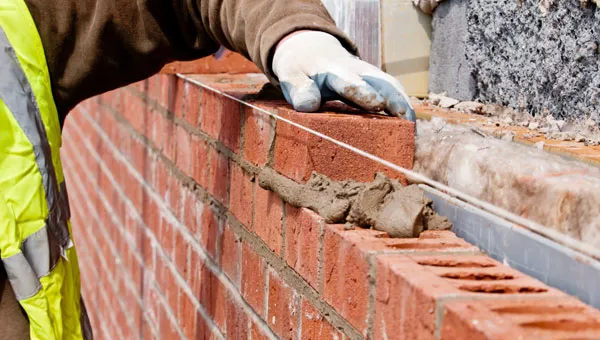Unlocking the Secrets of Sustainable Masonry Building And Construction Practices for Eco-Friendly Structures
Amongst the myriad approaches to eco-friendly building, sustainable stonework building and construction stands out as a reliable and resilient method that holds a wide range of untapped possibility. From the selection of materials to innovative construction strategies, the secrets to accomplishing sustainability within masonry construction are multifaceted and interesting.
Benefits of Lasting Masonry Building And Construction
Accepting lasting masonry building practices not only minimizes ecological effect however additionally uses lasting financial advantages to building contractors and neighborhoods. By using materials like recycled blocks, blocks, and stones, contractors can substantially reduce the carbon footprint of their jobs while advertising resource efficiency. Additionally, lasting stonework building methods, such as appropriate insulation and thermal mass residential properties, can boost energy effectiveness within structures, resulting in decreased functional prices in time.
Additionally, the toughness and resilience of stonework frameworks add to lasting financial benefits. Structures created using lasting masonry techniques often call for less repair and maintenance, translating to set you back savings for building contractors and homeowner. The longevity of masonry materials likewise guarantees that structures stay steady and safe and secure, decreasing the need for frequent improvements or replacements.
Eco-Friendly Stonework Products
Making use of environment-friendly stonework materials is a pivotal step in the direction of improving the sustainability of building and construction methods and lessening ecological impact while maximizing long-lasting financial benefits. Lasting stonework products are sourced, produced, and made use of in a fashion that reduces general environmental impact. Materials such as recycled bricks, redeemed rock, and sustainable cinder block are coming to be progressively popular choices for eco-conscious builders. Recycled blocks, for instance, not only divert waste from land fills however also call for less power to produce compared to brand-new blocks. Reclaimed stone supplies an unique visual allure while minimizing the need for new quarrying. Sustainable concrete obstructs include recycled accumulations and may feature better insulation homes, adding to power effectiveness in structures.
In addition, natural materials like adobe, rammed earth, and straw bales give superb thermal mass buildings, minimizing the requirement for heating and cooling down energy. These products are commonly locally readily available, promoting local economic climates and lowering transportation-related carbon discharges. By selecting green stonework materials, building projects can substantially decrease their ecological footprint and go to my blog add to the development of healthier, extra sustainable developed atmospheres.
Energy-Efficient Stonework Strategies
Energy efficiency plays an important function in improving the sustainability of masonry building techniques. One key energy-efficient masonry method is the use of thermal mass, which includes integrating thick materials like concrete or brick right into the structure's structure to take in and save warmth.

Developments in Lasting Masonry
Current developments in lasting stonework methods have actually caused innovative strategies that are improving the construction market. One such innovation is the development of self-healing concrete, which makes use of bacteria installed within the concrete to recover splits autonomously. This breakthrough not only reduces maintenance expenses but also improves the longevity of stonework structures, adding to their sustainability.
One more noteworthy advancement is making use home of recycled accumulations in masonry building and construction - masonry contractor. By incorporating materials such as smashed ceramic waste or recycled glass right into concrete mixes, contractors can reduce the ecological influence of construction tasks while maintaining architectural stability. This technique not just draws away waste from land fills but also conserves natural deposits, making it a key improvement in sustainable stonework construction
Furthermore, the combination of digital design tools, such as Structure Details Modeling (BIM), is changing the method masonry frameworks are planned and created. BIM permits for more accurate estimations, decreased material wastefulness, and enhanced energy effectiveness, eventually leading to even more sustainable building methods. These innovations jointly indicate a promising future for lasting masonry construction in the period of environment-friendly buildings.
Future Trends in Masonry Sustainability
With the innovative strides made in lasting masonry methods, the future fads in stonework sustainability are positioned to more transform the building industry. Among the crucial fads shaping the future of stonework sustainability is the boosted assimilation of innovation. Innovations such as Structure Information Modeling (BIM) and online truth simulations are being made use of to enhance masonry building and construction processes, bring about lowered product waste and enhanced visit their website energy efficiency in buildings.
In addition, the growth of novel lasting products is set to play a substantial role in enhancing the eco-friendliness of masonry construction. masonry contractor. Advancements like self-healing concrete, recycled accumulations, and bio-based binders are acquiring grip for their capability to lessen ecological effect while maintaining structural stability

Final Thought
In conclusion, sustainable stonework building techniques supply countless benefits for environment-friendly structures. masonry contractor. Developments in sustainable masonry are continuously being developed to better boost the environmental performance of buildings.